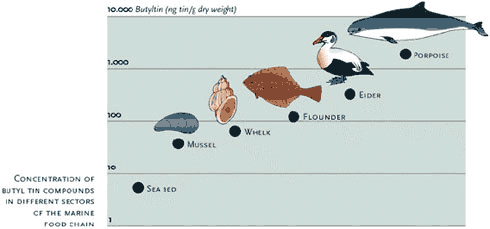Towards a Cleaner Marine Environment
8. Heavy shipping around Denmark
Shipping traffic is heavy in Danish waters. The Belts and Øresund - the entrances to the entire Baltic region - bear heavy traffic. But shipping traffic also damages the marine environment. Pollution by oil and the bottom paints used on ships are especially problematical.
Oil pollution at sea
It is illegal to release oil into the seas around Denmark. Nevertheless, Admiral Danish Fleet receives about 450 calls a year on oil pollution events, of which half prove to be of no significance or erroneous. The oil primarily originates in ships' engine rooms, from which water contaminated with oil is released, and from oil tankers, which release rinsing water after cleaning their tanks. Every oil spill at sea threatens the marine environment. Ecologically important areas can be harmed and fish and bird populations can be impacted. Birds are probably the species most threatened by oil pollution, as their feathers (which constitute an effective water-repellent and layer of thermal insulation) are destroyed when birds come into contact with oil. In the winter, an oil spot the size of a large coin is sufficient to reduce a bird's insulation to the point at which it dies. However, oil normally degrades rapidly.
Aircraft and satellites regularly monitor the sea around Denmark. Furthermore, all ships navigating in Danish waters are obliged to report any pollution they observe. A sample is collected for chemical analysis when an oil slick is observed. The reason for this is that every type of oil has a characteristic composition - a kind of fingerprint. The next step is to take an oil sample from a suspected ship. If the two samples match, there are grounds for prosecution.
Ships' bottom paints contain toxins
Almost all ships are protected against fouling by algae, barnacles and other small creatures. This is done by adding various toxins - the so-called "biocides" - to the bottom paint. Without this treatment, a ship's bottom becomes overgrown, so that it loses speed and steerage way, while fuel consumption increases. For many years, the most important antifouling product has been copper-based paint, to which a number of ancillary compounds are added. In particular, tributyltin (TBT) has been used as an additive. TBT has proved to be extremely detrimental to the marine environment. It has been found to cause sexual disturbances in snails, resulting in hermaphroditism, even at ultra-low concentrations. Unfortunately, we find snails with these deformities everywhere in Danish waters, for instance in dog whelk and red whelk, both of which are severely affected. TBT also accumulates in the food chain and possibly constitutes a health risk to man and animals. Porpoises have been found to have such high concentrations of TBT that their immune defence has possibly been compromised.

The use of TBT on ships smaller than 25 metres is now prohibited in Europe, and work is in progress on an international ban for all ships from 2003. New and environmentally less hazardous ships' paints are fortunately emerging on the market. But many years will elapse before TBT entirely disappears. Large quantities of TBT are bound to particles in the sea-bed, where it degrades only slowly and continues to constitute a risk through potential uptake in the marine food chain.